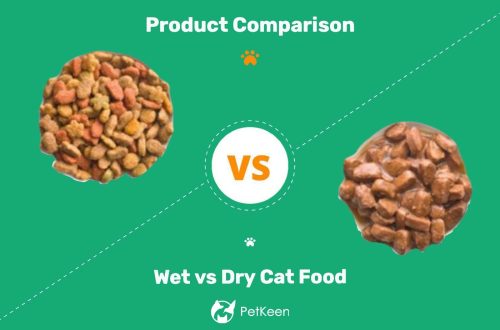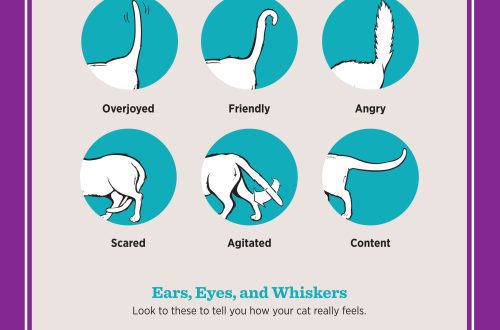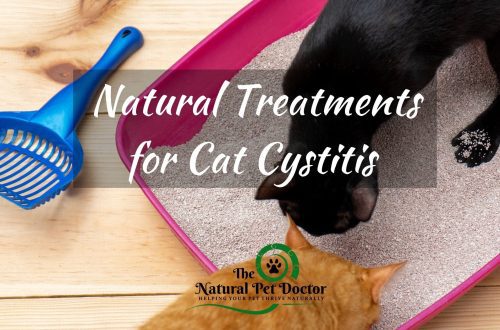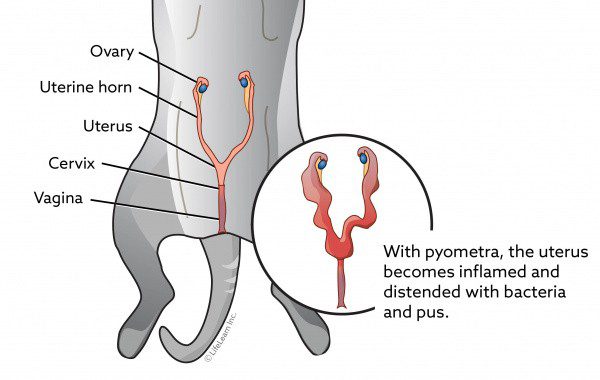
Pyometra in a cat – symptoms and treatment
Contents
Causes of pyometra in cats
Common causes of pyometra in cats include:
- hormonal imbalance. Stress, malnutrition, autoimmune diseases, hereditary pathologies can be provoking factors;
- hormonal contraceptives, which many owners give “so that the cat does not scream”;
- difficult childbirth;
- difficult cervical secretion associated with a sharp increase in the level of progesterone in the cat’s body after ovulation and a simultaneous weakening of the immune system;
- false pregnancies;
- infections of the genitourinary system caused by streptococci, staphylococci, Escherichia coli and others;
- artificially interrupted pregnancies;
- severe pregnancies that ended in stillbirth, intrauterine fetal death, intrauterine decomposition of the fetus and other anomalies;
- excess weight – negatively affects the state of the hormonal background;
- proliferation of connective tissue in the lumen of the cervix – prevents the normal secretion of cervical secretions;
- the formation of scar tissue in the neck;
- decrease or absence of uterine tone;
- mistakes of the owner or doctor during childbirth in a cat;
- injuries of the pelvic organs, including bones;
- neoplasms of a different nature – they can block the cervical canal, be a source of infection in the process of tumor decay.
All of these causes of pyometra are closely related. At risk are animals with empty estrus, over the age of 5 years.
How does pyometra appear in a cat?
Pyometra in a cat can occur in two forms: open and closed. The main symptom of the open form of the disease is discharge with an unpleasant odor from the animal’s genital tract. They can be liquid, bloody or purulent, mucus-like, with a gray or whitish tint. Other variants of consistency and color are also possible, but in all cases they clearly deviate from normal values. The volume of secretions with an open uterus also varies – they can be very plentiful or, on the contrary, scarce. And in fact, and in another case, the pet will lick all the time.
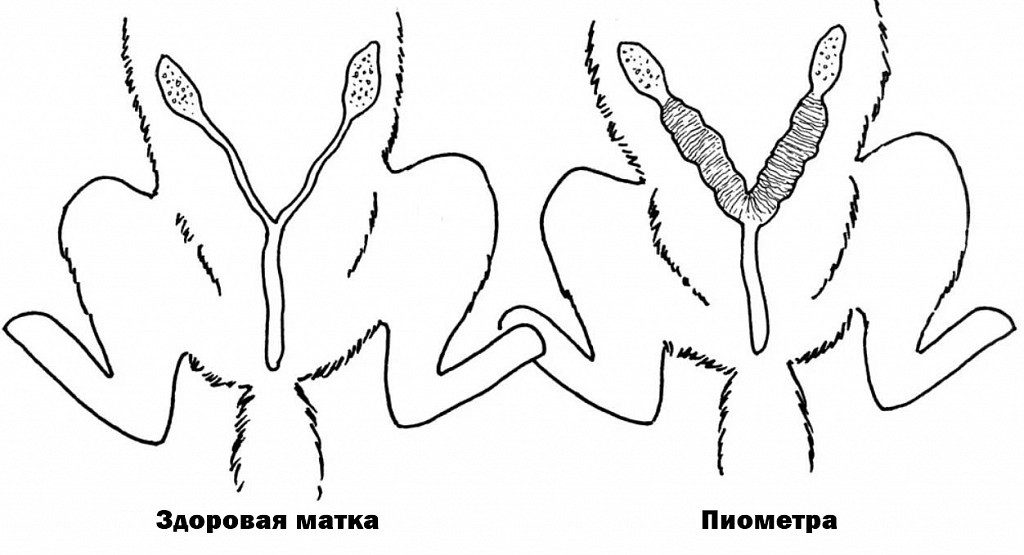
The closed form of pyometra poses a danger to the health and life of a cat, since exudate accumulates in the uterine cavity, and it is more difficult to detect pathology. Obvious symptoms of the disease occur when the walls of the organ are significantly damaged, and the body experiences severe intoxication. The signs of pathology in this case are as follows:
- pain in the abdomen – when pressed, the cat meows sharply, does not allow to be touched;
- incoordination of movement caused by convulsions and muscle spasms;
- reduced or, conversely, increased body temperature;
- apathy, depression, drowsiness;
- an increase in the volume of daily urine – indicates a violation of kidney function;
- vomiting;
- pathological, intense thirst;
- lack of appetite, exhaustion;
- diarrhea;
- an increase in the size of the abdomen.
Pathogenic microorganisms, toxic metabolic products, inflammatory metabolites in pyometra have a negative effect on all animal organ systems: respiratory, excretory, cardiovascular, nervous (brain). With the mass reproduction of pathogens, a cat develops a particularly serious condition – septicemia. This is a form of sepsis, which is characterized by rapid progression and severe intoxication. Lack of timely care and treatment of pyometra in cats can lead to rupture of the uterine wall and peritonitis.
Since the listed signs appear with significant damage to the uterus, first of all, you need to focus on changes in the behavior of the animal. Depression, apathy, thirst, refusal of food – these and other symptoms occur already in the first stages of the development of inflammation. It must be borne in mind that pathology can also develop in a pregnant cat.
Diagnostics
In the clinic, the veterinarian will examine the pet, ask the owner about the living conditions of the animal, listen to complaints, and prescribe an examination.
- General biochemical blood test. A large number of neutrophils indicates an ongoing inflammatory process. Dehydration, infections are indicated by high values of total protein. The breakdown of tissues in the body is indicated by an increased level of urea, uric acid and other products of protein metabolism.
- Cytological examination of a smear from the vagina. The detected bacteria, leukocytes will tell about the presence of inflammation.
- Bacteriological examination of a smear from the vagina. The aim is to detect and speciate microorganisms for the correct selection of antibiotics.
- X-ray. Shows the presence of pus in the uterus of a cat.
- Ultrasound of the pelvic organs. The same as x-ray, but with greater certainty.
- ECG. Gives information about the state of the cardiovascular system.
Differential diagnosis is carried out with pregnancy, inflammatory processes in the vagina, pathological changes in the kidneys, diabetes, disorders in the endocrine system.
The data obtained make it possible to identify exudate in the uterine cavity, determine its volume, the degree of damage to the organ, and choose the appropriate method of treatment – conservative or surgical.
Treatment of pyometra
How is pyometra treated in cats? The task of the conservative method is to preserve the reproductive function. For this, therapy with antibacterial and hormonal drugs is used. Treatment is considered successful if, at the end of the treatment, the uterus returns to its normal size and the cat feels satisfactory. Allocations in this case can be observed for another month. After the treatment, doctors advise immediately allowing the animal to mate. This recommendation is due to the fact that the inner layer of the uterus during pregnancy is practically not susceptible to infectious effects. After delivery, the cat’s uterus must be removed to avoid recurrence of pyometra.
It should be noted that drug treatment is carried out in several stages, and requires the animal to have strong immunity and physical strength. Hormones and antibiotics greatly weaken the immune system and also activate uterine contractions. This can lead to the following complications:
- rupture of the uterine wall;
- peritonitis;
- anomalies in the development of fetuses;
- infertility;
- exacerbation of existing chronic diseases.
In practice, even if the condition of the animal improves, the likelihood of recurrence of pyometra remains high. The situation is complicated by a decrease in immunity and a large number of side effects of drugs.
In almost 80-85% of cases of drug therapy, it does not give any effect, so experts recommend an operative method. It is better to perform the operation immediately after the diagnosis is established, since over time the cat’s body will weaken even more, and if a relapse develops, it will not be able to endure anesthesia.
Surgery is the main and emergency treatment for closed pyometra in a cat. The same applies to rupture of the uterine wall, tumor processes of peritonitis. The operation absolutely excludes the possibility of recurrence of the disease in the future, since both the uterus and the ovaries are removed. In this case, the standard method (scalpel) or laparoscopic can be used.
It should be noted that the operation to remove the reproductive organs of a cat is also associated with risks. Firstly, the doctor’s work is complicated by the presence of purulent contents in the uterine cavity. With its large volume, there is a high probability of rupture of the organ wall during the operation. To prevent this phenomenon, hormonal therapy is preliminarily carried out. The intake of hormones contributes to the release of a certain amount of purulent exudate and a decrease in pressure in the uterine cavity.
Another risk is the development of internal bleeding. In addition, the animal may have a negative reaction to the surgical suture.
However, you should not be afraid of such problems, since in comparison with this, the complications of pyometra are much more serious.
Recovery period: what to do
To avoid divergence of the seams or infection, at the end of the operation, a bandage is put on the animal. The rehabilitation period lasts, on average, two weeks. Improvement in the condition with a favorable prognosis occurs in about 2-3 days. During the recovery period you will need:
- the first day to keep the cat hungry, otherwise there may be vomiting;
- if the pet has an appetite, give food only natural and only in crushed form; if she eats industrial feed, preference is given to wet canned food designed for sterilized and weakened animals;
- provide the cat with clean water by placing a cup next to the bed;
- a place for a pet must be equipped on the floor, since the cat after pyometra and surgery is too weak to jump higher.
The owner must strictly monitor the timely intake of prescribed medications by the animal. Basically, these are antibacterial and symptomatic drugs – antipyretic, anti-inflammatory, painkillers and others. It is important to ensure proper care of the seam. It should be clean, without signs of inflammation, suppuration. If there is severe redness, swelling, bloody or purulent discharge, you need to urgently show the animal to a veterinarian.
Possible complications
The main danger with pyometra in a cat is peritonitis and the subsequent death of the animal. Peritonitis develops in case of rupture of the uterine wall: the pus filling its cavity is poured into the abdominal cavity.
Another complication is coma, which can occur with severe dehydration of the pet. Since during a coma the body is greatly depleted, the cat dies.
Prognosis and prevention
The best prevention for pyometra is to spay the cat before the first heat or immediately after it (up to a year old). Other preventive measures include:
- attentive attitude to the animal, observation of the pet during and after estrus;
- timely access to a doctor in the presence of the slightest physiological or behavioral changes;
- restriction of street contacts;
- ensuring the physical activity of the cat;
- good nutrition, prevention of deficiency of nutrients and vitamins;
- exclusion of drugs based on hormones;
- with a false pregnancy – the exclusion of products that provoke lactation.
In addition, it is imperative to regularly visit the veterinary clinic for medical examinations, ultrasound of the pelvic organs, especially if the cat is at risk.



